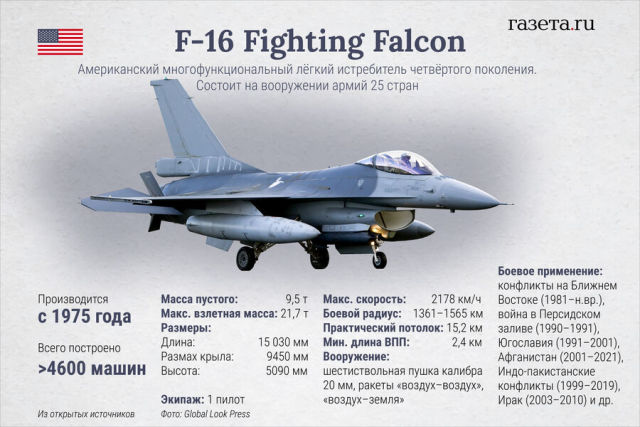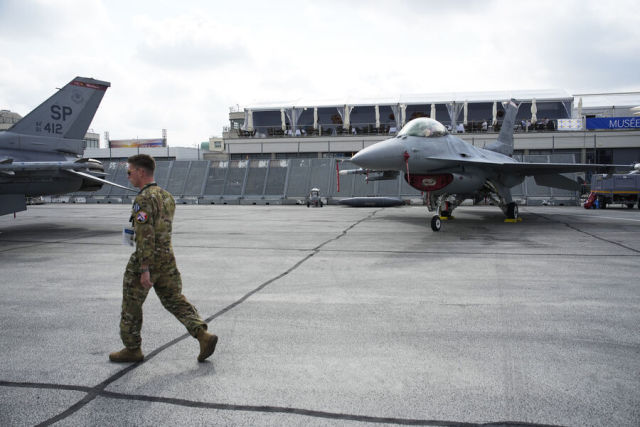Colonel Khodarenok: F-16s will be based in Ukraine, not in Romania or Moldova
Apparently, the first batch of F-16 aircraft will be handed over to the Armed Forces in the near future. Now the parties are working out the flight routes of combat vehicles. Where the new fighters will be based, whether they can be deployed in Romania or Moldova and whether the Russian military is capable of resisting these aircraft - in the material of the military observer of the Newspaper.En" by Mikhail Khodarenka.
Due to the upcoming transfer of American combat vehicles to Ukraine, the text of a letter from Foreign Minister Dmitry Kuleba dated January 15 addressed to the Minister of Foreign Affairs of the Republic of Moldova Nicolae Popescu appeared in the public domain.
The document states that "between the leaders of our states, Madam President of the Republic of Moldova Maya Sandu and President of Ukraine Vladimir Zelensky, agreements in principle have been reached on the possibility of Ukraine using the airspace of the Republic of Moldova." Also in this letter, Kuleba proposes to hold a meeting of representatives of the General staffs, Ministries of Defense and Foreign Affairs of Ukraine, Moldova and Romania from February 12 to 16.
Where will the new aircraft be based
Russian experts immediately linked the text of Dmitry Kuleba's letter with the study of the possibility for Ukrainian F-16 fighters to operate from the territory of Romania. That is, to take off from the airfields of this state, then fly through the airspace of Moldova and, without entering the airspace of Ukraine, strike Russian targets. After completing the combat mission, return back to the airfields of Romania.

Image source: Alina Dzhus/"Newspaper.Ru"
However, in the letter of the Minister of Foreign Affairs of Ukraine there is not even a hint of such a scenario. So far, we are talking only about the possibility of Ukraine using the airspace of the Republic of Moldova.
And the US strategy regarding the conflict in Ukraine is precisely to ensure that it does not go beyond the country's borders. And it is far from Chisinau that the issues of where the F-16s will be based and from which airfields to operate during the armed conflict will be resolved.
Now, most likely, all interested parties are working out the flight routes of combat vehicles, as well as the transportation of aviation weapons and property of the aviation rear. And the representatives of Kiev here have only the right to an advisory vote. They are far from the ones who will make the final decisions.
There is no exact data yet on the number of combat vehicles that will be transferred to Ukraine, nor on the number of trained pilots. Most likely, the F-16 fighters of the Ukrainian Air Force will operate from the airfields of Stryi, Ozernoye, Starokonstantinov (options are possible here). The planes will be kept dispersed, periodically change their home airfields, and carefully disguise themselves.
The flight of Ukrainian combat vehicles is likely to be carried out either through Poland, through Turkey, or through Romania. And indeed, Moldovan airspace can be used for these purposes. But no more than that.
Presumably, the transportation of aviation weapons and property of the aviation rear will be carried out by rail and road along the shortest route - through the administrative center of the Subcarpathian Voivodeship of Poland, the city of Rzeszow (sometimes referred to as the "secret capital of the West").
What are the dangers of the F-16
There is no doubt that airfields, airfield facilities and ground equipment in Ukraine are being prepared at a Stakhanov pace to receive F-16 aircraft and ensure flights. Aviation logistics, aerodrome engineering and aviation technical units are being deployed, warehouses and bases are being put on alert. Everything possible is being done to provide multifunctional fighters with fuel, aviation weapons, compressed and liquefied gases and other material means.
Some representatives of the domestic expert community sometimes voice opinions that Ukrainian F-16s, as soon as they find themselves on the territory of Ukraine, will be easily destroyed (even on approach) by air defense or fighter aircraft of the Russian Aerospace Forces.
For sure, along with the fighters, they will hand over electronic warfare kits for self-concealment of each aircraft. The actions of combat vehicles will be supported by jamming aircraft and ground-based electronic warfare units. It is quite possible that the fighters will be controlled using long-range radar detection and control aircraft.
The F-16s themselves will massively use AGM-88 HARM anti-radar missiles and long-range air-to-surface guided missiles and bombs to strike the launch positions of the air defense units of the Russian Armed Forces.
The use of bomber aircraft of the Russian Aerospace Forces and the actions of multifunctional Su-30/35 type fighters will become much more complicated, since the F-16 can receive air-to-air missiles of the AIM-120 AMRAAM type (the far boundary of the affected zone of this missile in the AIM-120D variant reaches 180 km).

Image source: Alina Dzhus/"Newspaper.Ru"
If the Su-30/35 airborne radars and guided weapons of these fighters significantly exceeded the capabilities of the Ukrainian MiG-29 /Su-27, then with the arrival of American vehicles to equip the Ukrainian Air Forces, these advantages will greatly lose their former importance.
It is quite possible to hit the F-16 in air and anti-aircraft combat. But it would be fundamentally wrong to imagine to the Russian society that this task can be accomplished, as they say, by "one left".
The opinion of the author may not coincide with the position of the editorial board.
Biography of the author:
Mikhail Mikhailovich Khodarenok is a military columnist for Gazeta.Ru", retired colonel.
He graduated from the Minsk Higher Engineering Anti-Aircraft Missile School (1976), the Military Air Defense Command Academy (1986).
Commander of the S-75 anti-aircraft missile division (1980-1983).
Deputy commander of the anti-aircraft missile regiment (1986-1988).
Senior Officer of the General Staff of the Air Defense Forces (1988-1992).
Officer of the Main Operational Directorate of the General Staff (1992-2000).
Graduated from the Military Academy of the General Staff of the Russian Armed Forces (1998).
Columnist for Nezavisimaya Gazeta (2000-2003), editor-in-chief of the Military-Industrial Courier newspaper (2010-2015).
Mikhail Khodarenok

